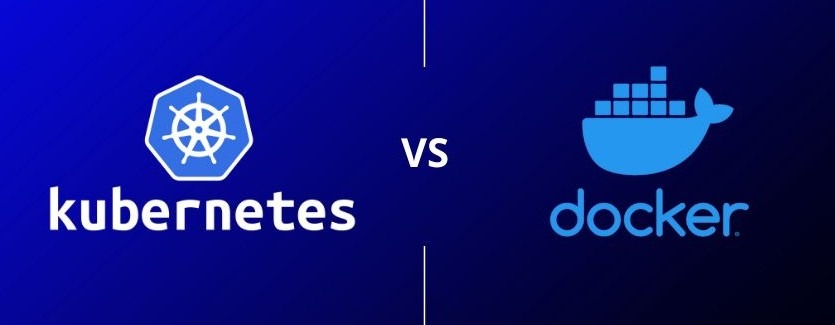Docker vs Kubernetes: What’s the Difference & Which One Should You Learn?
If you are starting your journey in DevOps or Cloud Computing, two words that keep popping up are Docker and Kubernetes. Both are super popular, both are widely used in IT companies, and both are often misunderstood. In this blog, we’ll break down Docker and Kubernetes in the simplest way possible.

What is Docker?
Docker is a platform for developing, shipping, and running applications using containerization. It provides the tools to package applications and their dependencies into lightweight, portable units called containers.These containers are portable, consistent across different environments, and make it easier to build, test, and deploy applications anywhere — from a developer’s laptop to cloud servers.
Use Cases of Docker
The following are the use cases of Docker:
- Simplified Development and Testing: Docker enables developers to create, test, and deploy applications in consistent environments, reducing "it works on my machine" issues.
- Microservices Architecture: Docker facilitates the adoption of microservices by allowing the packaging and deployment of each service as a lightweight, portable container.
- Continuous Integration and Continuous Deployment (CI/CD): Docker integrates seamlessly with CI/CD pipelines, enabling automated testing, building, and deployment of applications.
- Environment Standardization: Docker ensures consistency across multiple development, testing, and production environments, making it easier to manage and deploy applications across various stages.
What is Kubernetes
Kubernetes (often abbreviated as K8s) is an open-source container orchestration platform designed to automate the deployment, scaling, and management of containerized applications. Originally developed by Google and now maintained by the Cloud Native Computing Foundation (CNCF), Kubernetes provides powerful features like load balancing, automated scaling, self-healing, and rolling updates.
Use Cases of Kubernetes
The following are the use cases of Kubernetes:
- Microservices Architecture: Kubernetes efficiently manages and scales microservices, ensuring seamless communication and deployment across distributed systems.
- CI/CD Pipelines: By automating deployment processes, Kubernetes enhances continuous integration and delivery, reducing time to market and improving software quality.
- Hybrid and Multi-Cloud Deployments: Kubernetes supports seamless application deployment and management across multiple cloud providers and on-premises environments, offering flexibility and resilience.
- Resource Optimization: Kubernetes dynamically allocates resources based on workload demand, maximizing hardware utilization and reducing operational costs.
Key Differences: Docker vs Kubernetes
Docker1. Scope : Docker focuses on creating, packaging, and running individual containers.
2. Orchestration : Provides only basic orchestration through Docker Compose or Docker Swarm, suitable for small-scale setups.
3. Dependency : Historically the most common container runtime, but not strictly required by orchestration platforms anymore.
4. Container Runtime: Docker Engine provides its own runtime for building and running containers.
5. Networking Model: Uses a simple bridge network model, with port mapping to expose containers.
6. Storage: Relies on Docker Volumes or bind mounts for persistent storage.
7. Configuration: Managed with Dockerfiles (for images) and Docker Compose (for multi-container apps).
8. Scaling: Limited to single-host scaling with Docker Compose or Docker Swarm.
Kubernetes
1. Scope: Kubernetes manages and orchestrates entire containerized applications across clusters of machines.
2. Orchestration: Offers robust, production-grade orchestration with features like scaling, self-healing, and service discovery.
3. Dependency: Supports multiple container runtimes (containerd, CRI-O, etc.), not limited to Docker.
4. Container Runtime: Supports multiple runtimes (containerd, CRI-O, etc.), Docker is just one option.
5. Networking Model: Uses a flat, cluster-wide network where every Pod can talk to every other Pod without NAT.
6. Storage: Provides persistent storage through Persistent Volumes (PV) and Persistent Volume Claims (PVC), integrating with cloud storage backends.
7. Configuration: Managed with YAML manifests for Deployments, Services, ConfigMaps, and Secrets.
8. Scaling: Supports horizontal pod autoscaling, vertical autoscaling, and cluster autoscaling across multiple nodes.
Conclusion
Docker and Kubernetes are not direct competitors — they serve different but complementary purposes in the container ecosystem. Docker is primarily about creating, packaging, and running applications in lightweight containers, ensuring consistency across environments. On the other hand, Kubernetes is about orchestrating and managing those containers at scale across clusters, with features like automated scaling, load balancing, and self-healing.
In real-world DevOps, teams often use Docker and Kubernetes together: Docker to build containers, and Kubernetes to deploy and manage them in production. Understanding both is essential for anyone aiming to work in modern cloud-native environments.
Thu Aug 21, 2025

